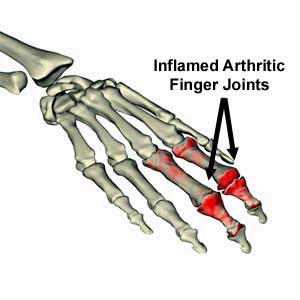
| ||||||
|

Arthritis Exercise And Pain Management Techniques
Living With Rheumatoid Arthritis


Introduction
Many people with arthritis find that small changes in the way they do things and in the techniques they use for pain management yield positive results. Managing moderate arthritis pain does not have to be complicated.
Exercise
Arthritis experts emphasize that a well-designed exercise program can decrease the pain and stiffness you feel ó while increasing your range of motion. Talk to your doctor about the kinds of exercise that best suits your particular needs.
While high impact activities such as running and floor aerobics can increase joint pain, regular gentle exercise (such as swimming, water aerobics and biking) has been shown to reduce or prevent joint pain. Exercise benefits your cartilage too as the action of the joints increases blood flow, which in turn brings nutrients to the joint and removes waste products. Building strong muscles around your joints can help to support them and reduce your chances of injury.
Strengthening and Range of Motion Exercises |
||||||||||||||||||||||||||||||||||||||||||||||
|
Try to put each of your joints through its full range of motion every day.
Remember that normal daily activities such as housework, climbing stairs,
lifting and bending do not put your joints through their full range of
motion.
In order to better protect your joints, the muscles surrounding a joint should be strengthened. Exercise is a good way to do this. Two basic types of exercise can help with pain relief: Stretching or range-of-motion exercises help you stay flexible while preventing stiffness and joint deformities. Strengthening exercises make the muscles, ligaments and tendons that support your joints stronger, thereby making movement less painful. Tips for beginners:
Exercises for your back: To stretch:
To strengthen:
Exercises for your knees: To stretch some muscle groups and to strengthen others:
Exercises for your hips: To stretch:
To strengthen:
Exercises for your ankles:
Exercises for your shoulders:
|
|
Joint Protection |
||||||||||
Listen to your body and stop any activity that causes ongoing pain.
Alternate heavy or repeated tasks with easy tasks or breaks in your daily
schedule. Change tasks often.
Use larger, stronger joints to carry loads. For example, carry a purse on your shoulder instead of with your fingers. Donít remain in the same position for a long time; get up and walk around periodically.
Take advantage of the many items that can help you cope with the tasks of daily life, such as items with longer or thicker handles.
|
||||||||||
|
Weight Control |
||||||||||
|
By reducing stress on your joints, controlling your weight helps prevent
osteoarthritis of the knees and other weight-bearing joints. And it lessens
pain in those who have it. To keep weight off, lose it gradually ó no more
than two to five pounds per month. Eat fewer calories and exercise more to
lose weight.
If you need to lose a lot of weight, work with your doctor or a registered dietician to find the best weight loss program for you.
|
||||||||||
|
Heat and Cold |
||||||||||
Applying heat or cold to sore joints can temporarily relieve the pain and
stiffness of osteoarthritis. Heat helps to relax aching muscles. Cold can
numb the area to reduce pain. Ask your doctor or therapist which method is
best for you. And follow these tips:
Heat methods include: electric blankets and mitts, heating pads, hot baths or showers, hot packs, hot towels, hot tubs, heated pools and paraffin wax. Cold methods include: bags of frozen vegetables, cold compresses, an ice cube or cubes wrapped in a towel, ice bags and cold packs.
|
This material is not intended as a guide to self-medication. The reader is advised to discuss the information provided here with a doctor, pharmacist, nurse, or other authorized healthcare practitioner and to check product information (including package inserts) regarding dosage, precautions, warnings, interactions, and contraindications before administering any drug, herb, or supplement discussed herein.